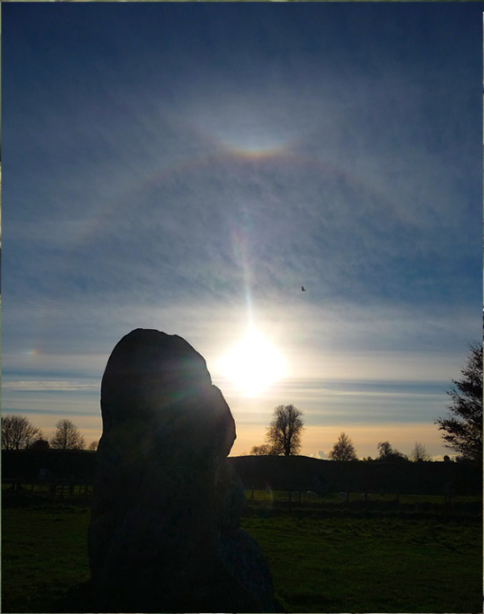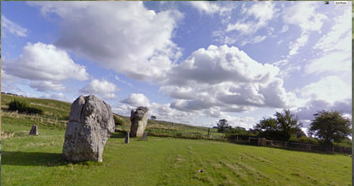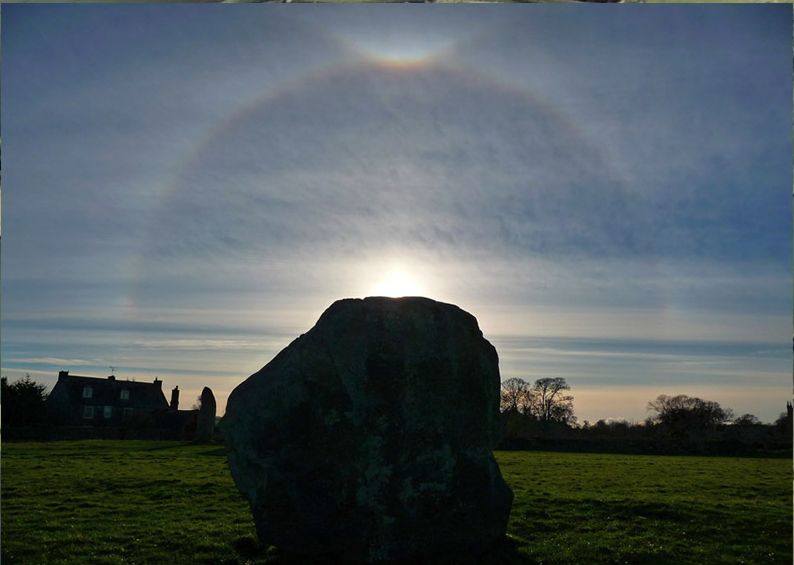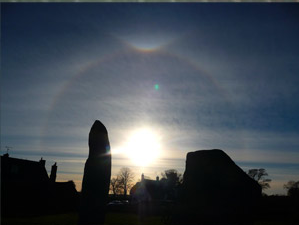OPOD - Avebury Halos
OPOD - Avebury Halos: A Fascinating Atmospheric Phenomenon
The Avebury stone circle, located in Wiltshire, England, is a captivating site steeped in history. Built by a prosperous and stable agrarian society between 4000 and 3500 BC, it is part of a larger Neolithic complex that includes a henge, avenues, and barrows. While the stone circle itself is a sight to behold, there is another enchanting spectacle that sometimes graces the skies above Avebury - halos.
Halos are optical phenomena that occur when light interacts with ice crystals suspended in the atmosphere. These ice crystals act as tiny prisms, bending and refracting light to create a stunning display of colors and shapes. The Avebury stone circle provides a unique backdrop for observing these halos, adding an extra layer of wonder to an already mesmerizing location.
One of the most commonly observed halos at Avebury is the 22° halo. This halo forms a complete circle around the low-hanging sun, creating a striking visual effect. It is caused by the refraction of sunlight through hexagonal ice crystals in the atmosphere. As sunlight passes through these ice crystals, it bends at an angle of approximately 22 degrees, resulting in the formation of the halo.
In addition to the 22° halo, Avebury sometimes treats onlookers to other halo phenomena. Sundogs, also known as parhelia, can be seen as faint patches of light on either side of the sun. These sundogs are created by plate-shaped ice crystals that are oriented horizontally in the atmosphere. When sunlight passes through these crystals, it splits into two separate beams, forming the sundogs.
Another fascinating halo phenomenon that occasionally graces the skies above Avebury is the upper tangent arc. This arc appears as a horizontal line above the sun and is formed by sunlight passing through horizontally oriented column-shaped ice crystals. These crystals refract the sunlight, causing it to bend and form the upper tangent arc.
The combination of these halos at Avebury creates a truly awe-inspiring spectacle. As visitors explore the ancient stone circle, they may find themselves captivated not only by the history and grandeur of the site but also by the ethereal beauty of the halos dancing in the sky above.
To capture the mesmerizing halos at Avebury, photographers like Andrew Collins have ventured to this historic site armed with their cameras. Through their lenses, they have immortalized these transient atmospheric phenomena, allowing us to marvel at their beauty long after they have faded from the sky.
As we delve into the world of atmospheric optics, it becomes evident that Avebury is not only a testament to the ingenuity of our ancient ancestors but also a canvas upon which nature paints its own breathtaking masterpieces. The convergence of human history and natural wonders creates a harmonious tapestry that invites us to contemplate the mysteries of the universe and our place within it.
So, the next time you find yourself at Avebury, take a moment to look up and witness the enchanting halo display above. Immerse yourself in the ancient aura of the stone circle while being transported to a realm where science and art intertwine, reminding us of the profound beauty that exists in both our human creations and the natural world.

Avebury Halos
Ice halo images by Andrew Collins at the Avebury prehistoric stone circle, Wiltshire, England November 16, 2010.
A 22° halo circles the low sun. To the left is a faint sundog from plate crystals and at top horizontal column crystals form an upper tangent arc.
©Andrew Collins, shown with permission.

Avebury is a huge Neolithic site with a henge, stone circles, avenues and barrows. The whole area was occupied 4000 to 3500 BC by a prosperous and stable agrarian society who built Avebury and several other monuments including nearby Stonehenge.
Non halo images ©Google & Getmapping plc


Note: this article has been automatically converted from the old site and may not appear as intended. You can find the original article here.
Reference Atmospheric Optics
If you use any of the definitions, information, or data presented on Atmospheric Optics, please copy the link or reference below to properly credit us as the reference source. Thank you!
-
<a href="https://atoptics.co.uk/blog/opod-avebury-halos/">OPOD - Avebury Halos</a>
-
"OPOD - Avebury Halos". Atmospheric Optics. Accessed on November 26, 2024. https://atoptics.co.uk/blog/opod-avebury-halos/.
-
"OPOD - Avebury Halos". Atmospheric Optics, https://atoptics.co.uk/blog/opod-avebury-halos/. Accessed 26 November, 2024
-
OPOD - Avebury Halos. Atmospheric Optics. Retrieved from https://atoptics.co.uk/blog/opod-avebury-halos/.